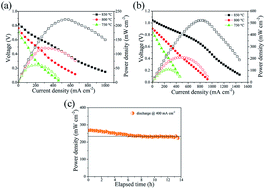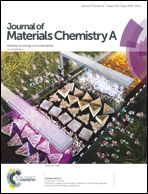Ce-doped La0.7Sr0.3Fe0.9Ni0.1O3−δ as symmetrical electrodes for high performance direct hydrocarbon solid oxide fuel cells†
Abstract
La0.7Sr0.3Fe0.9Ni0.1O3−δ (LSFNi) and La0.6Ce0.1Sr0.3Fe0.9Ni0.1O3−δ (CLSFNi) are synthesized and applied for use as symmetrical electrodes in direct-methane solid oxide fuel cells (SOFCs). In a symmetric SOFC, the same electrode material is used for both the anode and cathode and must therefore remain active in both oxidizing and reducing atmospheres. LSFNi and CLSFNi retain their stable perovskite phase at high temperature in both oxidizing and moderately reducing environments, with a minor amount of SrLaFeO4 phase (K2NiF4 structure) present under reducing conditions. Symmetric SOFCs incorporating either LSFNi or CLSFNi electrodes give excellent peak power densities of ∼900 mW cm−2 at 850 °C in wet H2/air (3% H2O). In wet CH4/air (3% H2O), the CLSFNi electrode greatly outperforms the LSFNi electrode (522 mW cm−2vs. 221 mW cm−2) due to the enhanced methane reforming activity imparted by the cerium doping. The performance and stability of the CLSFNi symmetric cell under direct CH4 operation are among the best reported to date in the literature, indicating that CLSFNi is a promising electrode material for symmetrical SOFCs.



 Please wait while we load your content...
Please wait while we load your content...